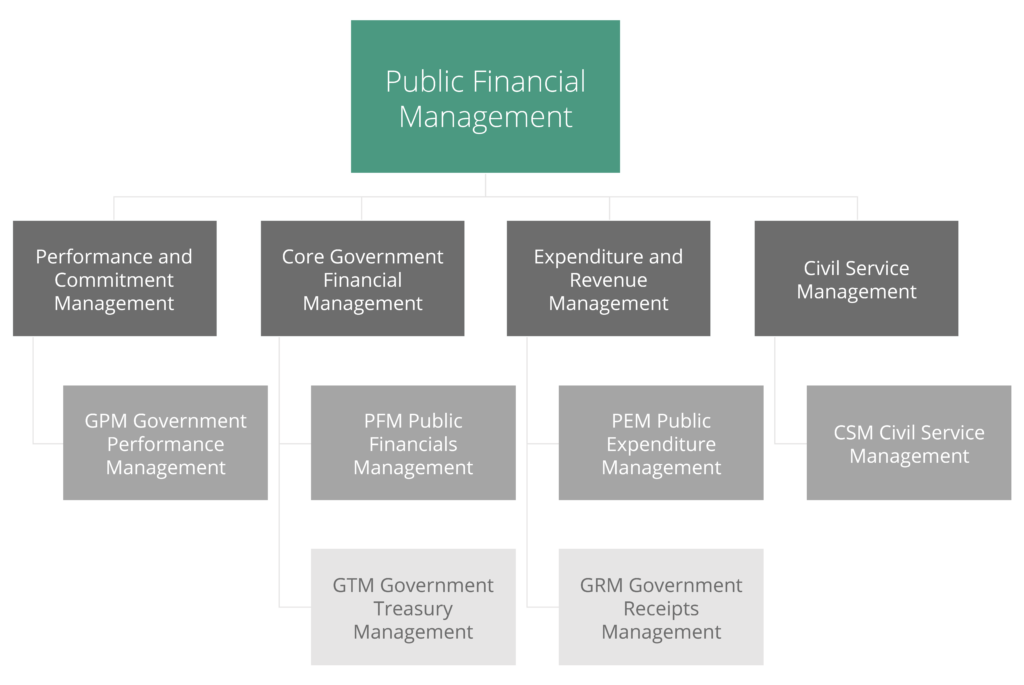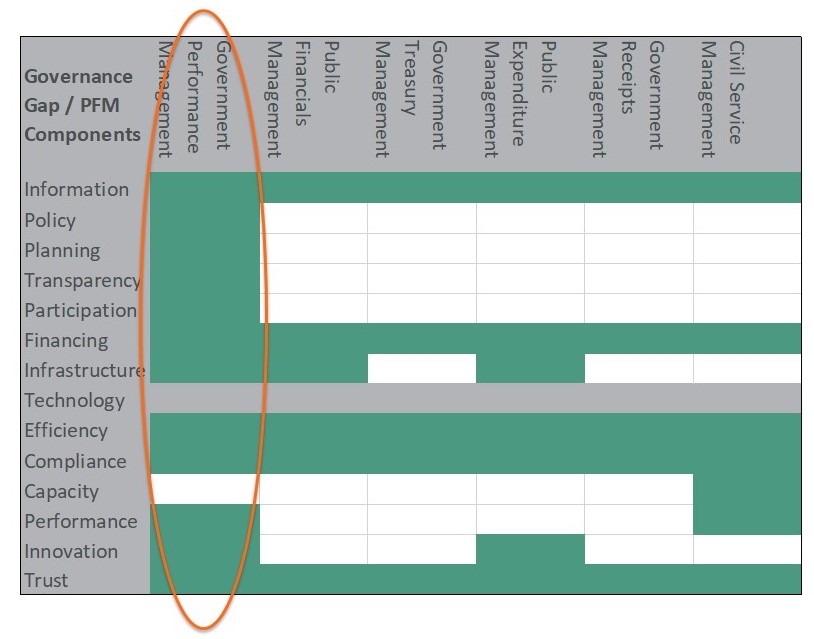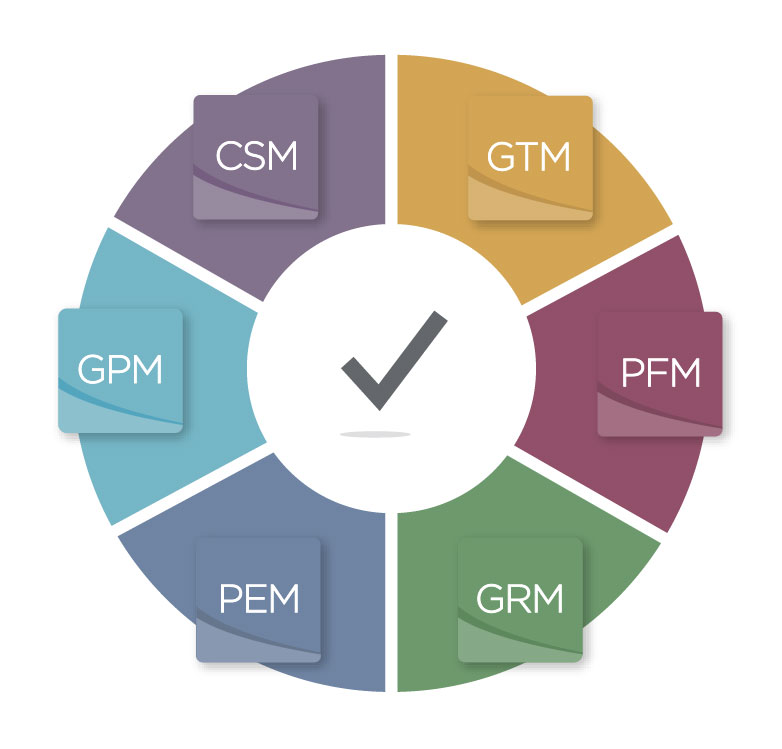Closing the Governance Gap
The reality is that the public sector is ill-prepared to deal with the opportunities and challenges of government digital transformation. This governance gap is a trillion-dollar annual problem.
Poor governance and weak institutions are recognized as the #1 perceived impediment to prosperity and citizen wellbeing.
What is a Governance Gap?
- Governments pursue policies that are disconnected from citizen needs and wants – a policy gap.
- Governments suffer from short-term political thinking that raises distrust in public institutions because of disappointing results – a planning gap.
- The result of short-term thinking is that governments are trillions of dollars in debt, and unable to effectively fund smart government solutions, even those with high potential returns – a financing gap.
- Silos of legacy government technology cannot provide policymakers with timely, comprehensive, or accurate information – a technology gap.
- The result of policy, planning, financing and technology gaps is crumbling infrastructure – a multiple trillion-dollar infrastructure gap.
- All of which leads to the biggest issue of all – a trust gap.
In other words, governments are implementing the wrong policies ineffectively, hamstrung by legacy technology that reduces the quality of decision-making, operating with insufficient funding to maintain legacy infrastructure – the governance gap.
It is critical that governments understand these governance gaps before they embark on a GovTech journey. Simply installing technology in government is not going to solve the problem.
Successful government digital transformation requires a gap analysis. Constraints demonstrate where digital initiatives could be successful. More importantly, a gap analysis helps governments to overcome gaps that block the road to success. The use of government technology specifically designed to address governance gaps can fundamentally transform a government and country.
All Governance Gaps Lead to the Trust Gap
An analysis of the dependencies amongst the various governance gaps, illustrates just how reliant trust is on effective governance. To close the Trust Gap, governments have to deliver on all the other gaps. And technology in government is a powerful enabler for this.

How Can GovTech Close the Governance Gap?
The implementation of a Public Financial Management (PFM) GovTech solution such as the FreeBalance Accountability Suite™ is critical to this transformation. Technology in government has enormous potential but the right system needs to be used. And the solution needs to be locally sustainable.
Unlike ERP systems designed for the private sector, the FreeBalance Accountability Suite™ is a bespoke Government Resource Planning (GRP) solution designed with government, for government. Functionality is directly aligned with the PFM needs of government, as expressed in the PFM Component Map.

Digitally Enabled Government Through PFM and GovTech
A comprehensive GRP covers the entire government budget cycle, all public financial functions, and non-financial functions associated with PFM functions. The most important functionality to address the governance gap, lies within the Government Performance Management (GPM) pillar which empowers governments to achieve better results through access to data and metrics. The ability to tie performance directly to budgeting allows for improved outcomes for public sector departments.

GPM applications such as budget planning, performance structures, transparency portals and management dashboards have the biggest impact on closing a government’s governance gaps.
Can GovTech Help Promote Democracy?
Yes. The analysis below of the governance gaps (the problems that a government faces) and the required solutions shows exactly how use of the right technology in government can improve government performance. Better outcomes lead to more stable and prosperous countries, delivery against the United Nations Sustainable Development Goals, and an environment conducive to improved citizen wellbeing and a flourishing democracy.
How the FreeBalance Accountability Suite™ Addresses the Governance Gaps

| Problem | Solution | GovTech Implication | FreeBalance Accountability Suite™ Functionality |
|---|---|---|---|
| Information Gap: Lack of effective, consistent, coherent, timely, and quality information for decision-makers because of data silos, lack of data collection, with poor information governance and integration, rather than effective unified data | Unified Information: Common metadata across all financial subsystems, aligned with budget classifications as core source, extendable to big data sources such as IoT, documents, web pages, and social media feeds | Use of unified systems where metadata is shared across subsystems Use of metadata management systems with strong data governance for integration Near real-time integration for timely information Use of governance technology platform that functions as a “service bus” | All applications Focus on Government Performance Management: applications for reporting, scorecards, dashboards and alerts |
| Policy Gap: Policy is informed by the information gap, so policy reverts to political dogma, or effective unified data is downplayed in favour of dogma because of confirmation bias, rather than policy aligned to citizen priorities, or citizen-centric policy | Citizen-Centric: Methods to better align government policy with citizen perceptions of value collected through surveys, sentiment analysis, participatory budgeting, 3rd party reports about happiness and wellbeing | Document and collaboration tool linkages to combine structured and unstructured analysis Use of budget outreach open government functionality Use of fiscal portals for transparency | Government Performance Management: Policy, transparency and open government applications |
| Planning Gap: Focus on annual budgets rather than medium term, combined with the information gap and policy gap leads to short-term planning where priorities that are misaligned to citizen concerns, even if understood, and effective unified data, if collected | Priority Alignment: Development of budget allocations tied to citizen-centric policies holistically with integrated views of capital, operating, salary, and development budgets | Use of performance and program structures in budget classifications aligned to policy Sufficient information for planning analysis Alignment of outcome goals from data collection to the performance structure Multiple year perspective because important initiatives, such as large public investments, take time to implement and for results to be revealed Multiple version support during budget preparation, with narrative, to track allocation decision-making Efficient processes executed by informed public servants | Government Performance Management: budget planning applications |
| Transparency Gap: Lack of fiscal transparency or usability of transparency information even when planning is effective and priorities are aligned to citizen needs | Fiscal Portals: Online government fiscal portals that include multiple year budget information (original budget, budget transfers, final budget), budget plans or budget books with narrative, government financial statements, public investment results for large projects, procurement tenders and awards, audit reports | Support deployment of structured and unstructured data, including automatic assembly of documents from structured data, like budget book Common metadata and classifications to provide near real-time information Search, sort, and filter functionality | Government Performance Management: transparency portals |
| Participation Gap: Lack of citizen engagement because of limited participation, poor fiscal transparency, and antiquated planning methods that does not tap into citizen, civil society or business capacity to solve problems, identify policy priorities, and audit results, even when governments have unified data and effective planning techniques | Open Government: Online and offline methods for citizen engagement to encourage positive political activity, citizen oversight, efficacy and tax compliance, while providing valuable information for personal and business decisions | Effective and understandable fiscal portals with accurate information Collaboration and case management software functionality Surveys and participatory budgeting applications | Government Performance Management: budget planning applications |
| Financing Gap: High debt and limited financing option challenge governments to invest in citizen priorities, especially when previous planning has led to poor outcomes | Anticipatory Scenarios: Use of scenario planning, sensitivity analysis, and statistical modelling to predict cost and benefit effects of important public investments, such as infrastructure and social public investments, such as mental health prevention, to identity best financing methods that also reduce risk perception among funders | Effective, reliable and consistent data for projections Integration of budget planning, debt planning and sovereign wealth data Integration with non-financial sources, such as economic data like commodity pricing, interest rates, and exchange rates Risk articulation and mitigation methods in planning Ability to recast scenarios based on current data when scenarios are imminent Ensure effective debt, cash and spending execution to optimize fiscal space | Government Performance Management: budget planning Public Financials Management: fiscal controls to achieve credible budgets Government Treasury Management: liquidity and debt management Government Receipts Management: tax and non-tax revenue collection Public Expenditure Management and Civil Service Management: spending controls |
| Infrastructure Gap: Trillions of dollars of additional infrastructure investments are needed annually to achieve sustainable growth, where the proven economic returns for infrastructure cannot be financed even when there is effective planning | Public Investments: Alignment of public investments with citizen priorities and sustainable economic growth | Program and performance classifications tied to citizen-centric policy information Integration of capital budgeting for construction with projections for operating budget for maintenance of realistic infrastructure plan Register of infrastructure assets and values for maintenance, disposal and replacement analysis Integration of maintenance and usage information for financial projects, and preventative maintenance to reduce costs | Government Performance Management: public investment planning Public Expenditure Management: public investment procurement Public Financials Management: asset, facilities and property management |
| Technology Gap: Lack of modern integrated information systems in government, with antiquated legacy systems and legacy ERP, leads to an info gap for decision-makers, particularly for measuring policy success, while making fiscal transparency difficult, with high technical debt and maintenance costs that restricts spending for new cost-effective systems | Post-Modern Flexibility: Use of modern and adaptable GRP software to meet current and future needs in financially sustainable ways | Use of open systems and open source, rather than vendor-proprietary systems, to reduce vendor lock-in Highly configurable environments augmented by no-code and low code systems, rather than highly customized systems that are complex to change, maintain and upgrade, while meeting government capacity Deployment agility to run on public cloud, private cloud, community cloud, government shared services or on-premises Ability to model future costs to reduce technical debt and refresh systems | FreeBalance Accountability Platform™ FreeBalance Accountability Suite™ |
| Efficiency Gap: Antiquated and manual government processes from the pre-digital era, and legacy technology adds friction to government service delivery | Process Automation: Automation, workflow and intelligent systems that eliminate manual and antiquated processes | Access to data to track business process efficiency Progressive activation through configuration methods to enable phased migration to more modern processes and to support government reform Process automation functionality such as workflow, exception handling, and integration with knowledge bases Support for machine learning and artificial intelligence such as conversational UIs, chatbots, and Robotic Process Automation | FreeBalance Accountability Suite™ has full automation across all applications |
| Compliance Gap: Manual processes and legacy technology leads to inadvertent compliance gaps such as overspending procurement or payroll budgets through lack of budget integration, or deliberate compliance breaches such as corrupt practices in procurement and tax collection | Unified Controls: Shared budget, commitment, approval, and alert controls across subsystems | Unified metadata management across subsystems Unified and shared control structures Alert and audit management functionality | Controls across all FreeBalance Accountability Suite™ applications |
| Capacity Gap: Focus on antiquated processes, legacy technology and top-down focus of government human resources often leads to public service capacity that falls behind private sector capacity leading to poor planning decisions | Talent Management: Methods for public service capacity building, retention, promotion, succession, performance appraisal, and merit incentives | Integrated human resource and payroll systems to align incentives Cascading performance structures Long-term salary planning systems to measure impact of merit pay | Civil Service Management: capacity building, talent management, recruitment, performance management |
| Performance Gap: Legacy technology, complex outcomes, poor capacity, investments, and planning, leads to government performance that does not meet citizen expectations even when citizen priorities are understood | Performance Alignment: Cascading performance structures from policy through budget allocation to performance appraisal for programs, projects, and public servants | Performance aligned with citizen-centric policies Data-driven performance insights through unified data Budget allocations aligned to priorities High public servant capacity augmented by modern systems that automate routine tasks | Government Performance Management: performance structures, salary planning Civil Service Management: capacity building, talent management, recruitment, performance management |
| Innovation Gap: Conservative focus in public investments leads to inefficient complex procurement resulting in legacy technology and infrastructure adoption, and program implementation saddled by poor planning that is not tied to citizen priorities | Smart Public Investments: Agile methods to improve outcomes for citizens through scaling experiments | Initiatives tied to citizen priorities Performance structures tied to innovation Agile and automated procurement Unified data to support data-driven experiments | Government Performance Management: performance structures Public Expenditure Management: agile procurement and contract management |
| Trust Gap: Lack of citizen engagement, public sector corruption, poor transparency and performance erodes trust in government leading to lower credit ratings, poor tax compliance, and increased conflict | Outcomes and Accountability: Governments accountable for meeting important outcomes meeting citizen aspiration | Detailed and reliable data to gauge outcomes, including tracking across the entire budget cycle, particularly large public investments Government priorities tied to citizen needs Citizen feedback and ideas Budget allocations tied to citizen priorities that can be sustained Reduced errors, improved citizen services through automation on adaptable modern systems Strategic selection of innovation tied to citizen priorities Fiscally transparent government to generate trust including presentation of public investment results | All applications of the FreeBalance Accountability Suite™ lead to improved trust in government |
For more information on how FreeBalance can help implement a GovTech solution in your country to address any governance gaps you may have, please get in touch.